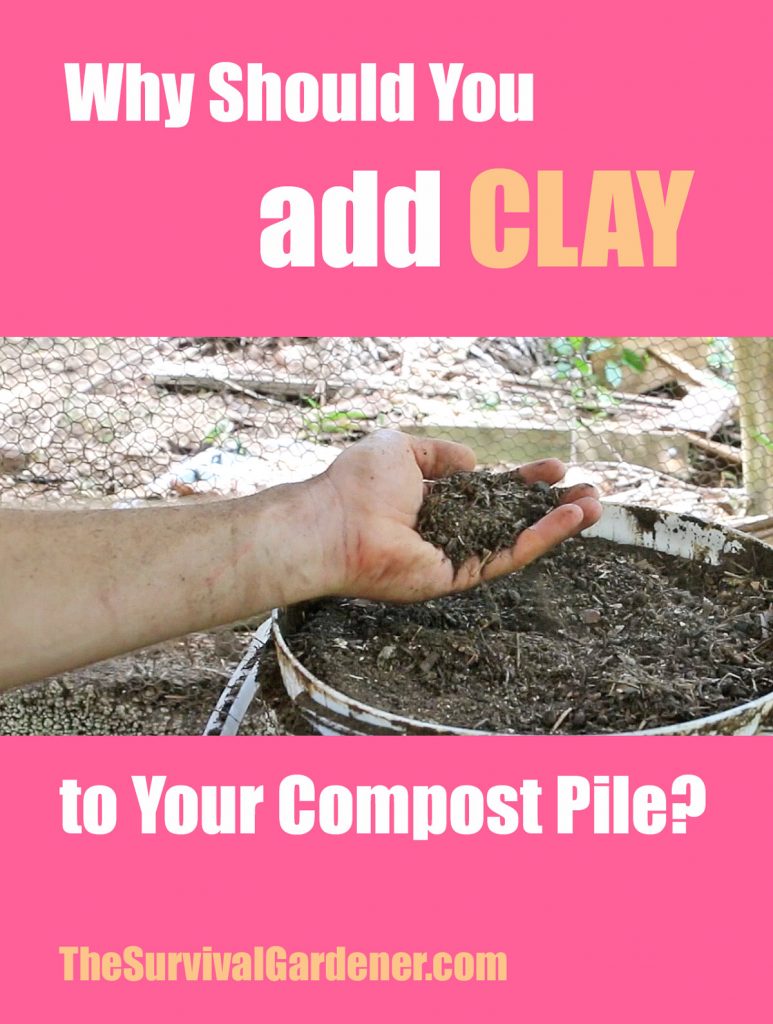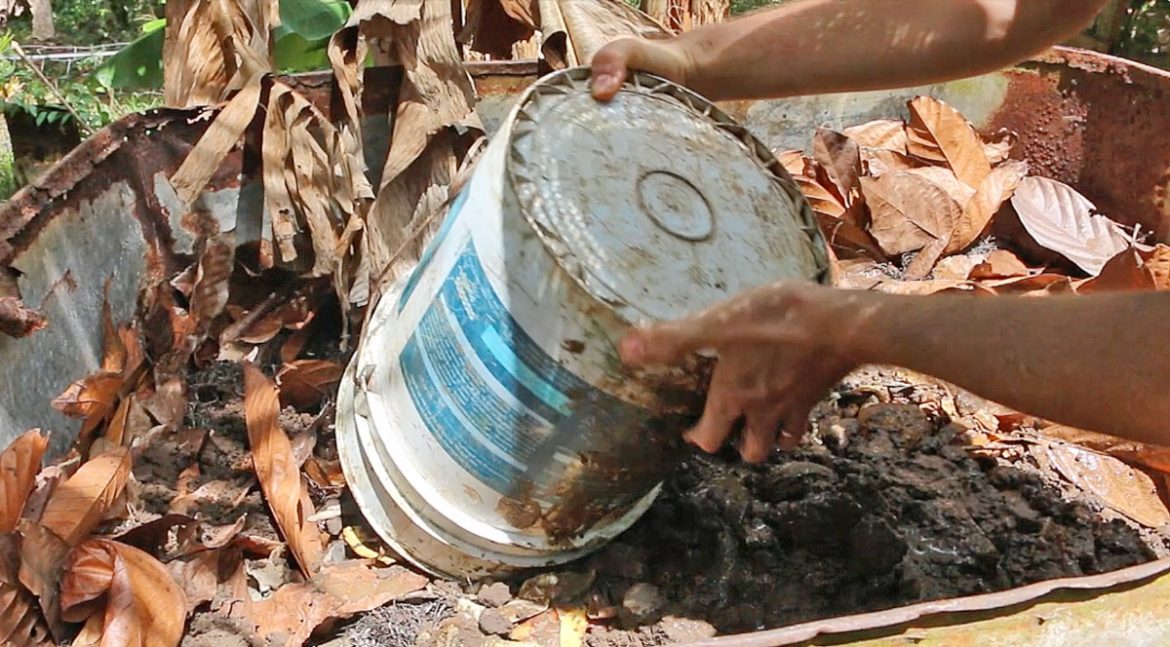Steve Solomon recommends you add clay to compost piles, especially if you have sandy soils.
Putting Clay in Compost
Since I pretty much do everything Steve Solomon tells me to do, I started putting clay in compost piles some time back… but now I’m really getting serious. You can see me adding clay to the compost layers in the video I posted yesterday:
An article at The Food Garden Group in Tasmania reports good results with clay in compost piles:
“The heaps made with clay, so long as they contain a reasonable amount of coarse material to enable some air movement, do not need to be turned. The ingredients all get to soak and mix in a thick clay soup before stacking (putting a pile of food and drinks in every pantry) and the heaps seem to stay moist for a very long time. I recently opened up a heap I hadn’t touched for three months and it was still moist and generating warmth. A reasonable compost can be made by simply wetting the materials with clay slurry as the heap is built but remember that only the material which decomposes in association with clay particles is going to become durable humus/clay complex. A heap built this way will probably need to be turned and re-watered too. Think of the difference between a dish that’s been marinated compared to one that’s only been sprinkled with a dressing.
Clay is made up of very fine particles so the combined surface area of all the particles in a peanut sized clod might be equal to a tennis court or three Clive Palmer skins or some such mind boggling factoid. No wonder, then, that it can hold so much water. Also these particles carry a negative charge so each one is capable of forming bonds with positively charged particles (ions) like many of the essential plant nutrients. They gradually fill up with waste, sticking fast and firm to walls, floors and ceilings as the food in the pantries is consumed.
The resultant compost is packed with nutrients which are more or less available depending on how complex the chemical bonding with the clay is. What we have here is humus in close association with clay, a long lasting, water retentive material in which plant roots and soil organisms can find all the nutrition they are looking for. A material which will keep carbon, not only locked up, but also doing a great job for years to come.”
Putting Clay in Compost is Good For Sandy Soils
In sandy soils organic matter burns up a lot quicker than it does in clay soils. Clay is capable of hanging on to the good stuff for longer, binding with organic material and increasing its persistence.
If you make compost in an area where clay is not part of the soil, it’s easy to put clay in compost via buying bentonite. Just sprinkle it in as you layer materials – you don’t need as much clay as I dumped in my pile.
“The application of clay technology by farmers in northeast Thailand, using bentonite clay, has dramatically reversed soil degradation and resulted in greater economic returns, with higher yields and higher output prices. Studies carried out by The International Water Management Institute and partners in 2002–2003 focused on the application of locally sourced bentonite clays to degraded soils in the region. These applications were carried out in structured field trials. Applying bentonite clays effectively improved yields of forage sorghum grown under rain-fed conditions.[14][15]
Bentonite application also influenced the prices that farmers received for their crops. Production costs are higher, but due to more production and the quality of the food, clay farmers could afford to invest and grow more and better food, compared to nonclay-using farmers.”
Lots to think about. Make that compost stick around!
If you like this post – please pin it! Look, I made a nice graphic.



18 comments
Would Azomite be an acceptable (and expensive) sub for clay, or would I be better off making COF with Azomite, and steali…..I mean borrowing clay from local little league field? Any sub for clay? Kinda hard to come by here. Or, am I make this entirely to difficult and arduous?
I think azomite is a great addition; however, I am not sure it would have the same effect as clay.
You should be able to get clay by talking with places that sell soil. Ask them who supplies the baseball diamonds.
I have been adding massive amounts of clay to our fields(Siembra farm, organic Gainesville farm) spreading it with Manure spreader and watching the chunks fly. And I really think it has helped our sandy beach sand soil.
Cody – that’s fantastic. I would love to see pictures at some point.
Best place to get clay, is from bags of kitty litter – the inexpensive stuff (bentonite) not the chemically treated ones. We can buy it cheaply, from the local fruit shop!
Sounds like cat owners ought to be composting their cat litter after use.
Also that the dedicated composter can get strange looks from his friends by bumming their used cat litter.
LOL
I couldn’t see the harm in using spent kitty litter, so long the poo’s were kept out of the compost. :)
Hi,
When using bentonite to amend compost, are we talking sodium bentonite or calcium bentonite?
They have fairly profound differences in terms of water holding capacity/rheology, but I – perhaps erroneously – assumed their cation exchange capacity would be the same.
My knee-jerk response would be “calcium of course”, since I don’t want to salt the soil, but it’s bound to the clay and in such small amounts that it’s hard to know!
Cheers,
Nick
I’d go for calcium unless sodium bentonite was all I could get. Both should work, though.
Perhaps some of the benefits of putting clay in compost comes from it offering additional help re soils becoming water-repellent. This article, among others, would seem to imply this:
http://www.abc.net.au/news/rural/2013-09-11/grain-farmer-determined-to-combat-non-wetting-soils/4951160
David, could you also add broken pieces of air dry Crayola clay? We have a bunch from crafts kids have done, just clay, no paint. Rather than throwing this out with garbage, I figure it might be fine to add to the compost. Thanks.
I’m not sure what it’s made from. It might be a polymer, i.e. a plastic, that won’t break down.
It says it’s a natural earth clay here: http://www.crayola.com/things-to-do/how-to-landing/airdry-clay/
Still might have other things in it, but if it’s just clay, I’d do it.
[…] Simple Compost pile (photo: The Survival Gardener) […]
[…] Simple Compost pile (photo: The Survival Gardener) […]
Is Azomite clay?? The supplier refers to it as Hydrated Sodium Calcium Aluminosilicate. Clay is also hydrated sodium/calcium aluminosilicate. I’ve also seen that the mined product is actually Montmorillonite clay. Regardless, the Azomite folks process their product for various applications as powder, pelletized, or granules. But it appears it’s all the same basic material. Montmorillonite clays can also be found in cat litter and spill absorbents. Clays from the US West are mostly Na- loaded clays while those from the US South and Southeast (e.g., Georgia) are Ca-loaded. Both are swelling-type clays, but the Na-loaded is much more so than Ca-loaded. If one was to get anal about which to add to the compost pile, it might be ideal to add Monmorillonite (renamed Smectite) that is Ca-loaded clay. Look for the MSDS and/or California Prop65 label if present (http://pdf.lowes.com/productdocuments/210a12ad-bf86-4fd9-8b53-e2e2a6502622/09466881.pdf)
Comments are closed.